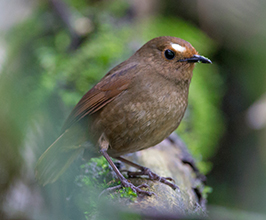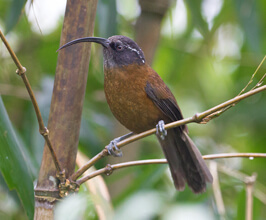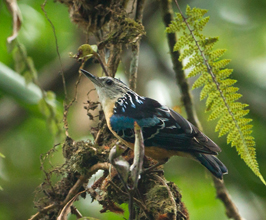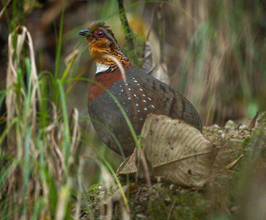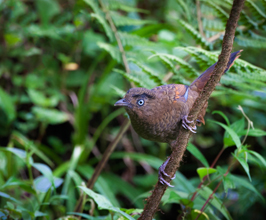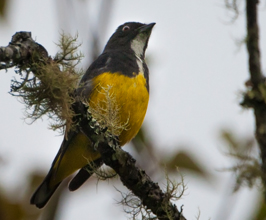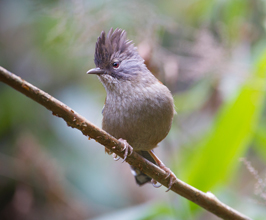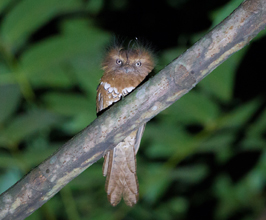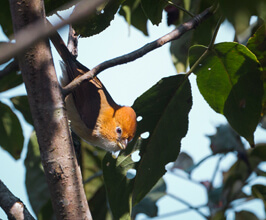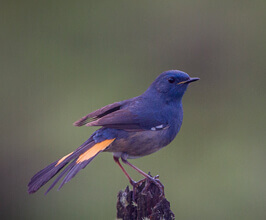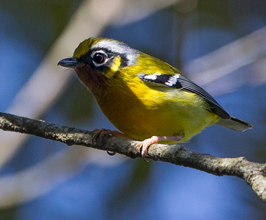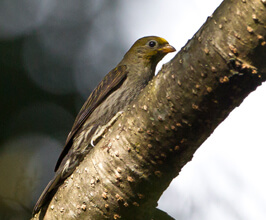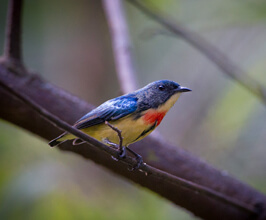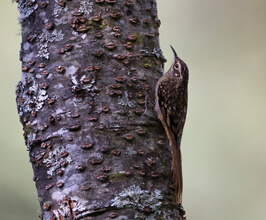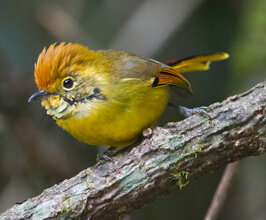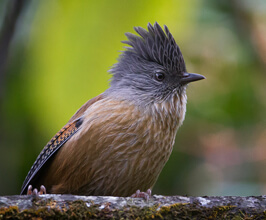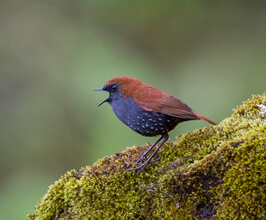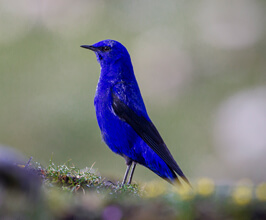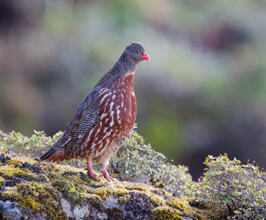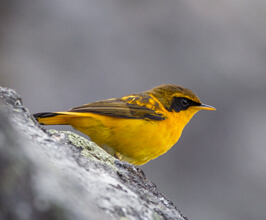Delhi – Guwahati – Nameri National Park - Lama Camp – Bompu Camp - Sessni Camp - Khellong - Eaglenest Pass - Dirang – Sangti Valley - Dirang – Sela Pass – Mandala Top - Kaziranga National Park - Shillong - Cherrapunji - Guwahati
17 Days / 16 Nights
Our Eaglenest & Meghalaya Birding tour is an elaborate birdwatching expedition, chockfull of wildlife safaris, multi-altitude birding.
Booked as per
request.
Included except arrival and departure city.

Private guide for complete tour.
Airport to Airport.
2-8PAX
Included
Our Eaglenest & Meghalaya Birding tour is an elaborate birdwatching expedition, chockfull of wildlife safaris, multi-altitude birding, forest camping, and tons of Himalayan adventure to boot.
The tour spans three states of Northeast India: Arunachal Pradesh, Assam and Meghalaya, all sharing contiguous borders north to south, respectively. Each of these states offers a distinct birdwatching experience.
Eaglenest Wildlife Sanctuary, in Arunachal Pradesh, is located in the foothills of the Himalayas and is home to several hundreds of rare and exotic bird species in its temperate broadleaf, conifer and alpine forests at low and high altitudes. The sanctuary’s biggest avian attraction, Bugun Liocichla, is a relatively recent find and the reason why Eaglenest has become one of the best birding hotspots of India. Our birdwatching tour of Eaglenest covers the sanctuary’s best birding trails that we’ve singled out after years of experience. Some trails are so remote that we camp out in tents for days. Other trails lead us to high altitude birding at Sela Pass (4160m), Mandala Top (3000m) and Eaglenest Pass (2800m).
The bird targets for the Arunachal leg of our Eaglenest and Meghalaya birding adventure include Himalayan Cutia, Brown Parrotbill, Red-billed Scimitar Babbler, Coral-billed Scimitar Babbler, Blue-winged Laughingthrush, Rufous-throated Wren Babbler, Maroon-backed Accentor, Hill Partridge, Rufous-throated Partridge, Chestnut-breasted Partridge, Blyth's Tragopan, Temminck's Tragopan, Eurasian Woodcock, Wood Snipe, Jerdon's Baza, Crested Goshawk, Besra, Eurasian Sparrowhawk, Northern Goshawk, Snow Partridge, Himalayan Monal, Blood Pheasant, Grandala, Rare Gould's Shortwing, Solitary Snipe, Upland Buzzard, White-browed Rosefinch, Plain Mountain Finches, Eurasian Sparrowhawk, Red-billed Chough, Snow Pigeon, Alpine Accentors.
As a birding destination, the state of Assam is a formidable peer to Arunachal. A great many Indian bird species, resident and migratory, flutter about in the lowland evergreen forests, wetlands, and wildlife sanctuaries of Assam. Our Eaglenest and Meghalaya birding trip focusses of two of these sites: Kaziranga National Park and Nameri National Park.
Kaziranga, particularly, is the favourite stomping ground of wildlife lovers and birders. Here, we do several jeep safaris to watch not just the immense wildlife, including one-horned rhinos, but an incredible variety of avian specialties such as Bengal Florican, Lesser Whistling Duck, Greylag Goose, Ruddy Shelduck, Gadwall, Eurasian Wigeon, Northern Pintail, Ferruginous Duck, Asian Openbill, Woolly-necked Stork, Lesser Adjutant, Eastern Great Egret, Intermediate Egret, Spot-billed Pelican, Grey-headed Fish Eagle, Northern Lapwing, Grey-headed Lapwing, Green-billed Malkoha, Brown-headed Gull, Greater and Lesser Adjutants, Greater Spotted Eagle, Himalayan Griffon, Black-necked Stork, Garganey, Spot-billed Pelican, Red-crested Pochard, Spotted Redshank, Pallas’ Fish Eagle, Red-necked Falcon, Indian spot-billed Duck, Common Kestrel, Black Baza, Peregrine Falcon, Osprey, Pallas’s Fish Eagle, Grey-headed Fish Eagle, Western Marsh Harrier, Northern Lapwing, Grey-headed Lapwing and many more.
In the third and final leg of our North East India birding tour, we explore the lush and hilly forests of Meghalaya, targeting particularly the capital Shillong and the hill station of Cherrapunji, which is one of the wettest places on earth on account of rainfall. Here, we seek out birds like Amur Falcon, Himalayan Buzzard, Golden Eagle, Golden-throated Barbet, Long-tailed Shrike, Eurasian Crag Martin, Red-rumped Swallow, Striated Prinia, Hill Prinia, Crested Finchbill, Flavescent Bulbul, Grey-hooded Warbler, Spot-breasted Scimitar Babbler, Streak-breasted Scimitar Babbler, Tawny-breasted Wren Babbler, Ashy Woodswallow, Brown Shrike, Blyth's Leaf Warbler, Grey-hooded Warbler, Chestnut-bellied Nuthatch, Chestnut-tailed Starling, Common Hawk-Cuckoo, House Swift, Oriental Honey-buzzard, Grey-capped Woodpecker, Short-billed Minivet, Blyth's Shrike-Babbler, Green Shrike-Babbler, Tickell's Leaf Warbler, Paddyfield Pipit, Striated Swallow, and Cinereous Tit.
Our Eaglenest and Meghalaya birding adventure lasts 17 days, not one out of which is without a birdwatching session. The tour itinerary includes several full days of birdwatching and some half days as well. Each important birding area is thoroughly explored and birding trails are picked purposely to yield maximum sightings. Even the miscellaneous asides, such as night camps, birding lodges and the circuitous route through stunning mountainous terrains, make this tour more of an exotic Indian birdwatching adventure that you won’t forget for a long time.
Lodging: Most of our Eaglenest and Meghalaya birding expedition takes place at remote birding trails of Northeast India. Lodging in these parts is pretty basic, comprising of tented accommodation at Lama Camp and Bompu Camp, which also have common toilet. Premium accommodation is available only in Delhi, Dirang, Kaziranga, Shillong and Cherrapunji during the course of our tour. For two nights, you get to stay at a birding lodge in Mandala. Rest assured that the tents and lodges only add to your Northeast India birding adventure.
Meals: Meals vary according to accommodation. On the nights we stay in camps and lodges, our expert kitchen staff cooks delicious meals, both vegetarian and meat-based. Since cooking ingredients are limited in these far-flung areas, we depend solely on our stock, which does have enough variety to keep your belly satisfied for several days. On all occasions, our kitchen staff follows hygienic cooking practices. More meal options are available during our stay at Delhi, Nameri, Dirang, Kaziranga, Shillong and Cherrapunji. These places serve western meals as well.
Tour Difficulty: All the birding locations of our Eaglenest and Meghalaya birdwatching trip are accessible by motorable road. We traverse a mountainous terrain and do bird-walks at altitudes as high as 4160 meters and spend nights in a lodge at 3000 meters. You should be physically fit and strong to be able to withstand high-altitude conditions. The birding trails may require uphill or downhill slog, or simply long hours of walking with your birding equipment such as binoculars, camera, field guide and backpack. Given the rigours, we accept only birders aged between 15 and 65 for this tour.
Tour Extension: Northeast India holds out several tourist attractions. The region has many Buddhist monasteries with their ancient relics, colourful paintings, sculptures, quaint architecture, religious rituals and customs. You may want a trip to the monastery at Tawang in Arunachal Pradesh. Or you may want a wildlife safari in Manas National Park, or you may simply want to check out tourist hotspots near the birding trails. Whatever the tour extension you wish for, just let us know well in advance so that we can make necessary arrangements to extend the Eaglenest and Meghalaya birding holiday as per your liking.
Climate: The best time to do our Eaglenest and Meghalaya birdwatching tour is from October to mid-May. This is winter and spring season in the region and the weather is cold at high elevations of Sela Pass, Mandala Top, Eaglenest Pass in Arunachal, and Shillong and Cherrapunji in Meghalaya. For these locations, you must carry enough change of winterwear. The weather is somewhat warmer and pleasant at lower heights of Assam and summer clothes are suited for the spring season. Do carry a quality raincoat as well because Meghalaya is the wettest state of India.
India’s capital Delhi is where our birding adventure begins. Our representative receives you at the airport or railway station in Delhi and drives you to a pre-booked hotel. After a short rest break, we take you out for a birding tour of Delhi.
A metropolis like Delhi may not come across as a birding destination at first glance, but the Okhla Bird Sanctuary, located at Okhla barrage on the outskirts of the city, quickly puts paid to such notions. As many as 300 bird species have been spotted here and our targets for the day include Eurasian Collared-Dove, Laughing Dove, Yellow-footed Green-Pigeon, Greater Coucal, Asian Koel, Grey-headed Swamphen, White-breasted Waterhen, Black-winged Stilt, Red-wattled Lapwing, Pheasant-tailed Jacana, Temminck's Stint, Wood Sandpiper, Whiskered Tern, Oriental Darter, Great Cormorant, Indian Cormorant, Grey Heron, Cattle Egret, Indian Pond-Heron, Black-headed Ibis, Black Kite, Spotted Owlet, Indian Grey Hornbill, Common Kingfisher, Green Bee-eater, Brown-headed Barbet, Rose-ringed Parakeet, Black Drongo, Long-tailed Shrike, Ashy Prinia, Plain Prinia, Sykes's Warbler, Clamorous Reed Warbler, Plain Martin, Red-whiskered Bulbul, Indian White-eye, Striated Babbler, Rosy Starling, Bank Myna, India Robin, Oriental Magpie-Robin, Bluethroat, Pied Bushchat, Citrine Wagtail, Paddyfield Pipit, and Red-headed Bunting.
In the evening we return to our hotel for dinner and overnight. We sleep early because we have an early start the day after.
After an early breakfast, we drop you at Delhi airport for a flight to Guwahati in Assam. The 3-hour flight takes you into the heart of Northeast India. Our tour guide or representative meets you at Guwahati airport and takes you straightaway for a India Short Birding Tours of Guwahati. Though a bustling town, Guwahati still has a few places on its outskirts where one may see an interesting variety of birds. Our target for this short tour is Greater Adjutant Stork.
Freshened by this birding stint, we hit the highway for a 5-hour cab ride to Nameri National Park. We have our lunch at a roadside restaurant and arrive at our destination by evening, with a few hours to spare for some local birding.
Nameri National Park is situated in the foothills of the Himalayas, on Assam’s border with Arunachal Pradesh. It lies just below the sprawling Pakhui Wildlife Sanctuary of Arunachal Pradesh and this geographic bounty makes Nameri a thriving habitat of birds of Northeast India. It is also a tiger reserve with a lot of other wildlife such as leopard, elephant, hog deer, sambar, gaur and Indian giant squirrel. Our evening excursion is a short one after which we retire for the night to our resort in Nameri.
Nameri National Park is accessed by ferrying across the river Jia-Bhoroli, which flows along the southern boundary of the park. Crossing the river, one enters a biodiversity hotspot of semi-evergreen deciduous forests, bamboo brakes, and sporadic grasslands, which are home to a variety of flora and fauna, including 375 species of birds.
Quite early in the morning, we take a boat to cross the river and enter the park. We do birding walks on a selected stretch of the park and look for the likes of White-winged Duck (state bird of Assam), Blyth’s Kingfisher, Great Thick-knee, Wreathed Hornbill, Red-breasted Parakeet, White-capped River-chat, Long-billed Plover, Blue-naped Pitta, Wreathed hornbill, White-cheeked Partridge, Lineated and Blue-throated Barbets, Pin-tailed, Ashy-headed Green and Green Imperial Pigeons, Pied Flycatcher-Shrike, Yellow-browed, Greenish and Grey-hooded Warblers, Oriental Hobby, Pied Falconet, Pallas’s Fish-Eagle, Black Baza, Peregrine Falcon and Ibisbill.
Early morning birding at Nameri National Park is usually rewarding and we return to our resort for breakfast, after which we drive for about 4 hours to a place called Lama Camp. On the way, we stop by Sessa Orchid Sanctuary for a India Short Birding Tours. We arrive at our destination Lama Camp in the evening. Dinner and overnight at Lama Camp.
Lama Camp is the entry point to Eaglenest Wildlife Sanctuary. Since the sanctuary is spread over an area of 218 square kilometres, there is much to explore.
We set off right after the morning coffee to scan the forest around Lama Camp. Our main target for the day is the rare and critically endangered Bugun Liocichla, a small babbler whose discovery in 1995 and re-sighting in 2006 brought much fame to Eaglenest Wildlife Sanctuary as a birding destination. Apart from this little beauty, our targets for morning birding at Lama Camp include Himalayan Cutia, Brown Parrotbill, Red-billed Scimitar Babbler, Coral-billed Scimitar Babbler, Blue-winged Laughingthrush, Rufous-throated Wren Babbler, Maroon-backed Accentor, Hill Partridge, Rufous-throated Partridge, Chestnut-breasted Partridge, Blyth's Tragopan, Temminck's Tragopan, Yellow-rumped Honeyguide, Rufous Woodpecker, Pale-headed Woodpecker, Bay Woodpecker, Rufous-bellied Woodpecker, Crimson-breasted Woodpecker, Darjeeling Woodpecker, Golden-throated Barbet, Blue-throated Barbet, Blue-eared Barbet, Coppersmith Barbet, Great Hornbill, Ward's Trogon, Hodgson's Frogmouth, Barred Cuckoo Dove, Thick-billed Green Pigeon, and Mountain Imperial Pigeon.
So much birding comes out of the early morning hours at Lama Camp. After breakfast, we hit the road to Bompu Camp for a 32-km ride that goes through the Eaglenest Pass and several birding trails we stop by to explore. These excursions on the drive to Bompu Camp yield the likes of Eurasian Woodcock, Wood Snipe, Jerdon's Baza, Crested Goshawk, Besra, Eurasian Sparrowhawk, Northern Goshawk, Black Eagle, Rufous-bellied Eagle, Mountain Hawk Eagle, Blue-naped Pitta, Silver-breasted Broadbill, Long-tailed Broadbill, Golden-fronted Leafbird, Orange-bellied Leafbird, Collared Treepie, Spotted Nutcracker, Slender-billed Oriole, Maroon Oriole, Black-winged Cuckooshrike, Grey-chinned Minivet, Blue-capped Rock Thrush, Chestnut-bellied Rock Thrush, Plain-backed Thrush, Long-tailed Thrush, White-collared Blackbird, Chestnut Thrush, Yellow-bellied Flowerpecker, Bar-winged Wren Babbler, Beautiful Sibia, White-tailed Robin, Blue-fronted Robin and species of Parrotbills.
After a busy day of birding, we overnight at Bompu Camp.
What makes Bompu Camp a birding hotspot is its location. At the altitude of 1950 meters, it is situated between open fields on one side and dense forest on the others. Along the muddy road that cuts through Bompu are several tented accommodations that shall be our base for coming few nights.
After breakfast, we set out to explore the middle-forest range of Eaglenest Wildlife Sanctuary. We drive down to a place called Sessni Camp. The road goes downhill and presents great birding opportunities. On our birding excursions here, we look out for Sikkim Wedge-billed Babbler, Rufous-throated Hornbill, Grey Peacock Pheasant, Chestnut-breasted Partridge, Beautiful Nuthatch, Blue-naped Pitta, Long-tailed Broadbill, Golden-fronted Leafbird, Orange-bellied Leafbird, Lesser Shortwing, White-browed Shortwing, Dark-sided Flycatcher, Ferruginous Flycatcher, Purple Cochoa, Green Cochoa, Fire-capped Tit, Rufous-vented Tit, Coal Tit, Yellow-cheeked Tit, Striated Bulbul, Mountain Bulbul, Hill Prinia, Chestnut-headed Tesia, Slaty-bellied Tesia, Grey-bellied Tesia and several others.
After a fruitful day of birding around Sessni, we return to Bompu camp in the evening for dinner and overnight.
Since Eaglenest Wildlife Sanctuary is spread out over different altitudes, ranging from 500 meters to 3250 meters, we cover the birding trails at different altitudes. After scouring the mid-altitude Sessni camp on the previous day, we now move further down to the low range forest of the sanctuary.
After breakfast, we drive down all the way to the village of Khellong in the West Kameng district of Arunachal Pradesh. Khellong is a small village with a population that doesn’t exceed a few hundred. This fact, coupled with the village’s remoteness, has made Khellong and the areas nearby excellent spots for birdwatching in lower altitude of Eaglenest Wildlife Sanctuary.
On our full day birding expedition to Khellong, we aim to see the likes of Silver-bellied Broadbill, Blyth's Kingfisher, Eyebrowed Wren Babbler, White-hooded Babbler, several species of Shortwings, Rufous-vented Laughingthrush, Red-faced Liocichla, Abbott's Babbler, Buff-breasted Babbler, Spot-throated Babbler, Large and Hill Blue Flycatcher, Pale-headed Woodpecker, Slender-billed Scimitar, Red-headed Trogon, Rufous-backed Sibia, Long-tailed Sibia and a lot more. On the way back to Bompu Camp in the evening, we seek out Hodgson's Frogmouth. Dinner and overnight at Bompu Camp.
The birding trails at the altitudes lower than that of Bompu Camp so abound with avian specialities that we’ve had birders often asking us for longer spells of birding in these lower regions. For this reason, we have made a repeat birding excursion to Sessni and Khellong permanent in our itinerary of Eaglenest birding adventure in Arunachal Pradesh.
After breakfast, we head downhill again for Sessni and after crossing it we seek out Gold-naped Finch, Little Spiderhunter, Streaked Spiderhunter, Black-throated Sunbird, Scarlet-backed Flowerpecker, Long-billed Wren Babbler, Pigmy Wren Babbler, Lesser Rufous-headed Parrotbill, Greater Rufous-headed Parrotbill, Grey-headed Parrotbill, Red-billed Scimitar Babbler, Long-tailed Sibia and Rufous-backed Sibia. On this birding trail, we also get another shot to tick off Rufous-necked Hornbill, Wedge-billed Babblers and Beautiful Nuthatch in our checklist.
Descending to the still lower height of Khellong, we notice a change in the bird species. Here, we stand a better chance to see Speckled Piculet, Red-faced Liocichla and Red-headed Trogon. As the evening draws closer, we start moving back towards the height of Bompu Camp, but we keep birding on the way back. Dinner and overnight at Bompu Camp.
After breakfast, we pack up and drive towards Lama Camp and, on the way, we cross again the Eaglenest Pass, which has an elevation of 2800 meters. At the pass, we take a break from our journey to scour the nearby areas for the unchecked birds in our list.
Our targets for birding at Eaglenest Pass include Rusty-fronted Barwing, Streak-throated Barwing, Golden-breasted Fulvetta, Yellow-throated Fulvetta, Rufous-winged Fulvetta, Brown-throated Fulvetta, Nepal Fulvetta, Chestnut-tailed Minla, Fire-tailed Myzornis, Brown Parrotbill, Grey-headed Parrotbill, Fulvous Parrotbill, Mrs Gould's Sunbird, Green-tailed Sunbird, Fire-tailed Sunbird, Tibetan Siskin, Dark-breasted Rosefinch, Dark-rumped Rosefinch, Crimson-browed Finch, Scarlet Finch, Brown Bullfinch, Red-headed Bullfinch, Grey-headed Bullfinch and many more avian wonders.
As the evening draws closer, we continue our drive towards Lama Camp. If time permits, we may stop to cover some more birding trails on the way. Just close to Lama Camp is a Tragopanda Trail, where we stand a good chance to see Temminck’s Tragopan and Red Panda. Dinner and overnight at Lama Camp.
The day starts early with a breakfast, followed by a birding trip around Lama Camp. We check out the surroundings for the missing birds in our checklist. After this short birding trip, we pack up and leave for the town of Dirang towards west in Arunachal Pradesh. The drive takes about 4 to 5 hours and passes through Bomdilla town, which is a big tourist attraction on account of the Bomdilla Pass that affords great views of Gorichen and Kangto peaks. At Bomdilla we take a lunch break and then continue our journey to Dirang.
We arrive at Dirang and check into a pre-booked hotel in time to go out on a India Short Birding Tours of Sangti Valley about 15 km away. Sangti Valley is a picturesque vale surrounded by gorgeous Himalayan mountains. It is home to a wide variety of birds, making it a favourite haunt of many a birder in recent years. Here, we seek out the avian beauties such as Ibisbill, Long-billed Plover, wintering Wallcreepers, Black-necked Cranes and Black-tailed Crakes, among many others.
By evening, we return to our hotel at Dirang for dinner and overnight. We sleep on time so as to have an early start the day after.
At around 0330 hours, we begin our journey northwards to Sela Pass, which, at the altitude of 4160 meters, is rightly called the gateway to the town of Tawang. We carry our packed breakfast that we eat on the way. The idea behind this early start is to reach the vicinity of Sela Pass around daybreak.
Birding at Sela Pass starts about 9 km before the pass itself. In the first light of day, we begin our birding walk to look for the high-altitude birds of Arunachal Pradesh such as Snow Partridge, Himalayan Monal, Blood Pheasant, Grandala, Rare Gould's Shortwing, Solitary Snipe, Upland Buzzard, White-browed Rosefinch, Plain Mountain Finches, Eurasian Sparrowhawk, Red-billed Chough, Snow Pigeon, Alpine Accentors, Little Owl, Red-fronted Rosefinch, White-browed Tit-warbler, Himalayan Buzzard, Yellow-breasted Greenfinch, Dark-breasted Rosefinch, Himalayan Beautiful, Dark-rumped Rosefinch and several others. Sela Pass also offers stunning views of the eastern Himalayan peaks.
In the evening we drive back all the way down to Dirang and continue our journey southwards to a place called Mandala. In Mandala we check into a birding lodge. Dinner and overnight at the lodge.
Mandala Top is located about 30 km from Dirang. It is turning out to be a tourist attraction because of its recently-built cluster of 108 small Buddhist temples. Besides, the elevation of 3000 meters gives Mandala Top the vantage viewpoint of the mighty Himalayan mountain range. From the birding perspective, Mandala Top is a great place to look for high-altitude birds.
We do a full-day birding excursion at Mandala Top. Our targets for the day are Blanford's Rose Finch, Brown bush Warbler, Temminck's Tragopan, Gould's Shortwing, Naumann's Thrush, Red-throated Thrush, Black-throated/Plain-backed Thrush, White-bellied Redstart, Beautiful Sibias, Fire-capped Tit, Blue-fronted Robin, Spotted Nutcracker, Blue-capped Rock Thrush, Ward's Trogon, Slender-billed Scimitar-Babbler, Spotted Laughingthrush, Crimson-browed Finch, Large-billed Leaf-Warbler, Ludlow's Fulvetta, Rusty-flanked Treecreeper, Fire-tailed Myzornis, White-throated & Grey-sided Laughingthrushes, Red-tailed Minla, Yellow-browed, Black-browed and Rufous-vented Tits, Green-tailed Sunbird, Chestnut-tailed Minla, Black-faced Warbler, Stripe-throated Yuhina, Golden-breasted Fulvettas, Bar-tailed Treecreeper, Rufous-chinned and Grey-sided Laughingthrushes, Scaly-breasted Cupwing, Grey-sided Bush-warbler, Fulvous and Black-throated Parrotbills, Black-throated, White-collared and Grey-winged Blackbirds, Himalayan Bluetails, Eurasian Nutcracker, Speckled Wood-pigeon, Wood Snipe, Red Crossbill, Gould’s Shortwing, Scarlet Finch, Brown Bullfinch, Red-headed Bullfinch, Grey-headed Bullfinch, Collared Grosbeak, Spot-winged Grosbeak, Gold-naped Finch, and Little Bunting.
At Mandala Top one may also see interesting wildlife such as Red Panda, Himalayan Serow, Arunachal Macaque and Flying Squirrels. We overnight at Mandala birding lodge.
We pack up in the morning and set out on the long drive from Mandala Top to Kaziranga in Assam. The drive takes about 8 hours and the route passes through several birding habitats such as bamboo forests, rivers, and dense evergreen forests. We take a few breaks in our journey to explore some of these habitats and tick off the missing species in our bird checklist of Arunachal Pradesh.
Late in the evening, we arrive at Kaziranga National Park, a UNESCO World Heritage Site and one of the best wildlife reserves of India. Among the many attractions of the park are its one-horned rhinos. About 70 percent of the population of this special breed of rhinos is found here, apart from a splendid variety of wildlife, including wild Indian Elephants, Swamp Deer, Asiatic Water Buffalo and, perhaps the most sought-after of them all, the tiger. The park also hosts more than 450 species of birds, and birders from across the world come here every year to see several resident and migratory avian species. The Bengal Florican is a big draw here. For reasons of safety and conservation, birding at Kaziranga is allowed only by jeep or on elephants.
Upon arrival at Kaziranga, we check into a resort for dinner and overnight.
With an area of about 430 sq km, Kaziranga National Park is quite large and needs at least a few days of thorough exploring. The entire national park is divided into four ranges: Baguri in the west, Kohara in the centre, Agaratoli in the east, Biswanath in the north.
On this day, we do two wildlife and birding safaris at Kaziranga National Park: one in the morning, another in the afternoon. On both occasions we look for avian specialties such as, Bengal Florican, Lesser Whistling Duck, Greylag Goose, Ruddy Shelduck, Gadwall, Eurasian Wigeon, Northern Pintail, Ferruginous Duck, Asian Openbill, Woolly-necked Stork, Lesser Adjutant, Eastern Great Egret, Intermediate Egret, Spot-billed Pelican, Grey-headed Fish Eagle, Northern Lapwing, Grey-headed Lapwing, Green-billed Malkoha, Asia-barred Owlet, Large-tailed Nightjar, Black-billed Roller ,White-throated Kingfisher, Blue-naped Pitta, Ashy Wood Swallow, Common Iora, Grey-backed Shrike, Black-hooded Oriole, Cinerous Tit, Barn Swallow, Swamp Francolin, Red-whiskered Bulbul, Smoky Warbler, Yellow-browed Warbler, Puff-throated Babbler, White-browed Scimitar Babbler, Slender-billed Babbler, Greater Necklaced Laughingthrush, White-vented Myna, White-rumped Shama, Taiga Flycatcher, Little Pied Flycatcher, and Finn’s Weaver, among many others.
Goes without saying that apart from birds, you get to see a lot of wildlife during the two safaris. We dine and overnight at the resort in Kaziranga.
In the morning, we go on safari to the eastern range of Kaziranga National Park. This area hosts thousands of aquatic birds in the wetlands. The prized sights are those of Brown-headed Gull, Greater and Lesser Adjutants, Greater Spotted Eagle, Himalayan Griffon, Black-necked Stork, Garganey, Spot-billed Pelican, Red-crested Pochard, Spotted Redshank, Pallas’ Fish Eagle, Red-necked Falcon, Indian spot-billed Duck, Ferruginous Duck, Common Coot, Gadwall, Northern Lapwing, Lesser Whistling Duck, Tufted Duck, Ruddy Shelduck, Little Cormorant, Eurasian Wigeon and several others.
The afternoon safari is to the western range of Kaziranga National Park, where we get to see a lot of rhinos. This area abounds with birds, such as Common Kestrel, Black Baza, Peregrine Falcon, Osprey, Pallas’s Fish Eagle, Grey-headed Fish Eagle, Western Marsh Harrier, Northern Lapwing, Grey-headed Lapwing, Rose-ringed Parakeet, Blossom-headed Parakeet, Greater Coucal, Stork-billed Kingfisher, Pied Kingfisher, Blue-bearded Bee-eater, Oriental Pied Hornbill, Fulvous-breasted Woodpecker, Streak-throated Woodpecker, Ashy Wood Swallow, Long-tailed Minivet, Brown Shrike, Black-hooded Oriole, Black Drongo, Rufous Treepie, Velvet-fronted Nuthatch, White-vented Myna, Green Imperial-Pigeon, Lesser Coucal, Green-billed Large-tailed Nightjar, Asian Palm-Swift, Northern Lapwing, River Lapwing, Grey-headed Lapwing, Oriental Honey-buzzard, Himalayan Griffon, Brown Fish-Owl, Oriental Pied-Hornbill, Oriental Dollarbird, Coppersmith Barbet, Blue-eared Barbet, Red-breasted Parakeet, Long-tailed Minivet, Large Cuckooshrike, Cinereous Tit, Striated Grassbird, Striated Babbler, Chinese Rubythroat, Taiga Flycatcher, Black Redstart, Daurian Redstart, Scarlet-backed Flowerpecker, Golden-fronted Leafbird, Rosy Pipit, Brown Hawk-Owl, Scarlet Minivet, Clamorous Reed Warbler, Black-crested Bulbul, Yellow-browed Warbler, Dusky Warbler, Blyth's Leaf Warbler, Pin-tailed Snipe, Cotton Pygmy-Goose, Marsh Sandpiper, Pallas's Gull, Pale-chinned Blue Flycatcher, Pin-striped Tit-Babbler, Baya Weaver, Crimson Sunbird, Asian Emerald Dove, Indian Cuckoo, Golden-headed Cisticola, Thick-billed Warbler, Puff-throated Babbler, Bluethroat, Lesser-necklaced Laughingthrush, Forest Wagtail, Snowy-browed Flycatcher, Whistler's Warbler, Asian Brown Flycatcher, Little Pied Flycatcher, Red Avadavat, Pied Falconet, Dark-necked Tailorbird, Pygmy Flycatcher, Bengal Bushlark, White-throated Bulbul, Buff-chested Babbler, Rufous-necked Laughingthrush, Hen Harrier, Ruby-cheeked Sunbird, Asian Emerald Cuckoo, Short-toed Snake-Eagle, Pied Harrier, Yellow-bellied Prinia, Slender-billed Babbler, Oriental Skylark, Red-headed Vulture, White-rumped Vulture, Hodgson's Hawk-Cuckoo, and Red-necked Falcon.
Dinner and overnight at the resort in Kaziranga.
After an early breakfast, we hit the road for a 260-km journey from Kaziranga to Shillong, in the neighbouring state of Meghalaya, literally meaning the abode of clouds. The way cuts through some really spectacular locations in the green mountains of Meghalaya and the road is pretty smooth to make the journey comfortable and enjoyable.
We reach Shillong by afternoon and check into a hotel. After a short rest, we step out for a India Short Birding Tours of Shillong. The sprawling city sits on a plateau, but is surrounded by hills. It is lush with greenery and therefore holds out a birding prospect. We go birding at select locations and look for the likes of Ashy Woodswallow, Brown Shrike, Blyth's Leaf Warbler, Grey-hooded Warbler, Chestnut-bellied Nuthatch, Chestnut-tailed Starling, Common Hawk-Cuckoo, House Swift, Oriental Honey-buzzard, Grey-capped Woodpecker, Short-billed Minivet, Blyth's Shrike-Babbler, Green Shrike-Babbler, Tickell's Leaf Warbler, Paddyfield Pipit, Striated Swallow, Cinereous Tit, Red-rumped Swallow, Chestnut-bellied Rock-Thrush, Green-backed Tit, Grey Sibia, Velvet-fronted Nuthatch, Yellow-cheeked Tit, Silver-eared Mesia, Blue-winged Minla, Large Niltava, Yellow-browed Tit, Spotted Forktail, Rufescent Prinia, Yellow-browed Warbler, Slaty-backed Forktail, White-browed Scimitar-Babbler, Assam Laughingthrush, Grey-breasted Prinia, Himalayan Swiftlet, Dark-rumped Swift, Flavescent Bulbul, Buff-barred Warbler, Whistler's Warbler, Golden Babbler, Buff-chested Babbler, Grey-throated Babbler, Nepal Fulvetta, and Wallcreeper Brown Dipper.
Dinner and overnight at Shillong hotel. If you feel like dining out at some popular restaurant in the city, that may be arranged.
A relatively short drive of 55 km takes us from Shillong to Cherrapunji in the morning. Located at the elevation of 1430 meters, Cherrapunji is a hill station, a popular tourist spot, and one of the wettest places in the world owing to the amount of rainfall it gets every year. The steep road to Cherrapunji itself is often blanketed with mist and there are several stunning sights of waterfalls and rolling hills to tickle the landscape photographer in you. It’s a landscape straight out of a dream.
The abundance of vegetation in and around Cherrapunji is the reason it is as good a birding destination as a tourist hotspot. A day of birding in Cherrapunji often yields the likes of Amur Falcon, Himalayan Buzzard, Golden Eagle, Golden-throated Barbet, Long-tailed Shrike, Eurasian Crag Martin, Red-rumped Swallow, Striated Prinia, Hill Prinia, Crested Finchbill, Flavescent Bulbul, Grey-hooded Warbler, Spot-breasted Scimitar Babbler, Streak-breasted Scimitar Babbler, Tawny-breasted Wren Babbler, Rusty-fronted Barwing, Whiskered Yuhina, Chestnut-bellied Rock thrush, Yellow-bellied Flowerpecker, Green-tailed Sunbird, Fire-tailed Sunbird, Crimson-browed Finch, Brown Shrike, Himalayan Black Bulbul, Buff-barred Warbler, Grey Sibia, Blue-winged Minla, Velvet-fronted Nuthatch, Chestnut-tailed Starling, Yellow-cheeked Tit, Grey-hooded Warbler, and White Wagtail.
After a busy day, we retire to a hotel in Cherrapunji for overnight.
We start the final day of our Meghalaya birding adventure with a birding tour of Cherrapunji in the morning, following which we head out for a 150-km cab ride to Guwahati in Assam. On the way, we cross Shillong Peak at 1970m altitude, which gives a bird’s eye view of the Shillong city. More than the view, it is a good site to probe around for a few exotic birds of Meghalaya. Following this short session of birding, we continue our journey to Guwahati. We arrive in Guwahati in the evening and drop you at the airport for your onward journey. The Eaglenest and Meghalaya birding holiday ends.
